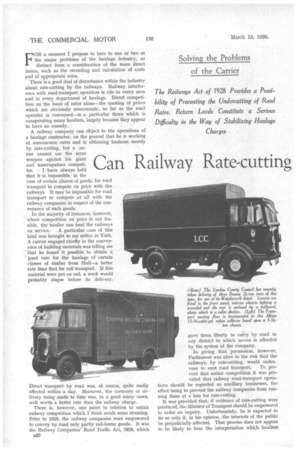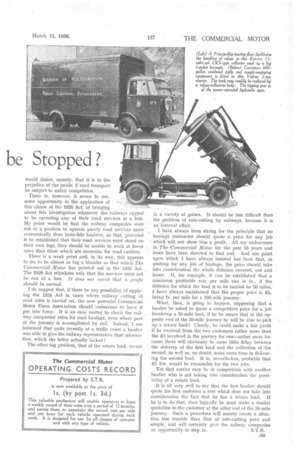Can Railway Rate-cutting
Page 104

Page 105

If you've noticed an error in this article please click here to report it so we can fix it.
The Railways Act of 1928 Provides a Possibility of Preventing the Undercutting of Road Rates. Return Loads Constitute a Serious Difficulty in the Way of Stabilizing Haulage
Solving the Problems of the Carrier
FOR a moment I propose to turn to one or two or the major problems of the haulage industry, as distinct from a consideration of the more direct. issues, such as the recording and calculation of costs and of appropriate rates.
There is a good deal of disturbance within the industry about rate-cutting by the railways. Railway interfer ence with road-transport operators is rife in every, area and in every department of haulage. Direct competition on the basis of rates alone—the quoting of prices which are obviously uneconomic, so far as the road operator is concerned—is a particular thorn which is exasperating many hauliers, largely because they appear to have no remedy.
A railway company can object to the operations of a haulage contractor, on the ground that he is working at uneconomic rates and is obtaining business merely by rate-cutting, but a .:-.ar rier cannot use the same weapon against his giant and unscrupulous competitor. . I have always held that it is impossible, hi the case of certain classes of goods, for road transport to compete on price with the railways. It may be impossible for road transport to compete at all with the railway companies in respect of the conveyance of such goods.
In the majority of instances, however, Where competition on price is not feasible, the haulier can beat the railways
on service. A particular case of this kind was brought to my notice at York. A carrier engaged chiefly in the conveyance of building materials was telling me that he found it possible to obtain a good rate for the haulage of certain classes of timber from Hull—a better rate than that for rail transport. If this material were put on rail, a week would probably elapse before its delivery.
Direct transport by road was, of course, quite easily effected within a day. Moreover, the certainty of delivery being made to time was, in a good many cases, well worth a better rate than the railway charge.
There is, however, one point in relation to unfair railway competition which I think needs some stressing. Prior to 1928, the railway companies were empowered to convey by road only partly rail-borne goods. It was the Railway Companies' Road Traffic Act, 1928, which c52
(Above) The London County Council has recently taken delivery of three Dennis 2i-ton bans of this type, for use at its Wandsworth depot. Louvres are Jilted in the front panel, interior electric lighting is provided and the rear is enclosed by a tailboard, above which is a roller shutter. (Left) The Transport moving floor is incorporated in this Albion 13-16-cubic-yd. refuse collector based upon a 3-31
gave them liberty to carry' by road in any district to which access is afforded by the system of the company.
In giving that permission, however, Parliament was alive to the risk that the railways, by rate-cutting, would endea vour to oust road transport. To . prevent that unfair competition it was provided that railway road-transport operations should be regarded as ancillary businesses, the effect being to prevent the railway companies from running them at a loss for rate-cutting.
It was provided that, if evidence of rate-cutting were produced, the Minister of Transport should be empowered to order an inquiry. Unfortunately, he is expected to do so only if, in his opinion, the interests of the public be prejudicially affected. That proviso does not appear to be likely to bear the interpretation which hauliers
would desire, namely, that it is to the prejudice of the public &road transport be subject to unfair competition..
There There is, however, it seems to me, some opportunity in the application of this .clause of the 1928 Act, of bringing abbut this investigation whenever the railways appear to be operating any of their road, services at a loss. My point would be that the railway companies were not in a position to operate purely road services more economically than bona-fide hauliers, so that, provided
• it be established that their road services must stand on their own legs, they should be unable to work at lower rates than those which are economic for road carriers.
• There is a weak point and, in its way, this appears to me to be almost as big a blunder as that which The Commercial Motor has pointed out in the 1933 Act. The 1928 Act stipulates only that the services mist not• be run at a loss. it does not insist that a profit should be earned.
I do suggest that, if there be any possibility of applying the 1928 Act in cases where railway cutting of road rates is carried on, the now powerful Commercial Motor Users Association should endeavour to have it put into force. It is art easy matter to check the rail. way companies' rates for road haulage, even where part of the journey is accomplished by rail. Indeed, I amn informed that quite recently at a traffic court a haulier was able to give the railway representative that information, which the latter actually lacked The other big problem, that of the• return load, occurs in a variety of guises. It should be less difficult than the problem of rate-cutting by railways, because it is an internal affair. .
I have always been strong for the principle that no haulage contractor should quote a price for any job ' which will not show him a profit. All my endeavours in The Commercial Motor for the past 16 years and snore have been directed to that end. And one point upon which I have always insisted has been that, in 'quoting for any, job of haulage, the price should take into consideration the whole distance covered, out and home. If, for example, it can be established that a minimum profitable rate per mile run is is., if the
• distance for which the load is to be carried be 50 miles, I have always maintained that the proper price is £5, being 1s. per mile for a 100-mile journey.
What, then, is going to happen, supposing that a haulier be asked to quote a competitive price for a job involving a .50-mile lead, if he be aware that at the opposite rnd of the 50--mile journey he will be able to pick up a return load? Clearly, he could make a fair profit if he received from the two customers rather more than the £15 involved in the journey for one—rather more because there will obviously be some little. delay, between • the delivery of the first load and the collection. of the second, as well as, no doubt, some extra tithe in deliver-,
• ing the second load. It is, nevertheless, probable that £5 10s. would be reasonable for the two jobs.
Yet that carrier may be in cornpetition with another haulier who is not taking into consideration the possibility of a return load.
It is all very well to say that the first haulier should quote his first customer a rate which does not take into consideration the fact that he has a return load. If he is to do that, then logically he must make a similar quotation to the customer at the other end of the 50-mile journey. Such a procedure will merely create a situation less tenable than that of rate-cutting pure and simple, and will certainly give the railway companies an opportunity to step in. S.T.R.


























































































































































